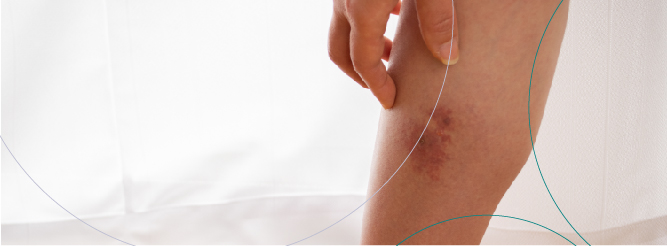
Osteoporosis is a common disease, that it’s characterized by bone mineral loss and an increase in bone fragility; It is associated with a decrease in quality of life, because the decreased of mobility because of pain and the deformed limbs. These decreased social interactions that lead to loneliness, isolation, and depression. It affects primarily women, but also affects men, is estimated that it affects 200 million women worldwide (2). This disease is diagnosed based on bone mineral density. The prevention regards on an adequate lifestyle [1][3].
What causes osteoporosis?
Osteoporosis has different origins and it’s classified into primary and secondary. The primary it´s the most common, is seen in persons over 70 years of age and in women that already have their menopause, and is caused by a deficiency of and hormone called estrogen, and a decrease in bone minerals. The secondary is caused most commonly by diseases and tumors. Also by unhealthy lifestyle conditions, habits, prolonged use of glucocorticoids, and depression [2].
Estrogen plays its important in the functioning of the bone, because this hormone helps to prevent the destruction of bone mineral.
Women who already had their menopause, the levels of this hormone decrease, so bone destruction is greater compared to bone remodeling, hence the risk of osteoporosis [4].
In menopause, bone density decreases significantly, which is why women who have already had their menopause have a high risk of osteoporosis. This is why prevention need to start before and during menopause [3].
How osteoporosis can be diagnosed?
To diagnose osteoporosis, the most common way is using a special x-ray test, taking information at various skeletal sites of the body, to measure bone mineral density. The WHO defines osteoporosis as a density less than 2.5 standard leads below the average value for young, healthy women [1].
What symptoms do osteoporosis have?
The symptoms of osteoporosis include, back pain mostly caused by a fracture on a vertebrate, decreased body height for the pass of the time, hunched posture or curved upper back, bone fracture and respiratory impairment. Fractures usually occur in vertebrae, arms, and hip [1].
Actions that helps in the prevention of osteoporosis
The prevention of osteoporosis in older age starts in childhood and adolescence because these stages are important in optimal bone formation. The majority of the optimal bone mineralization is from heritable factors, but modifiable factors such as exercise, adequate nutrition, body mass, and hormones affect optimal bone mineral density in adulthood, helping in the prevention of this disease [4].
There are some things that cannot be changed for prevention and increase the risk of having osteoporosis, like:
- Family history of this disease
- Age
- Race
- Gender
- Genetics
Also premature menopause and loss of ovarian function before menopause [1].
So the prevention of osteoporosis regards by a healthy lifestyle such as adequate nutrition, physical activities, adequate weight, stop smoking, limitate alcohol consumption, adequate calcium and vitamin D consumption and don’t use glucocorticoids by prolonged timeline [3].
Calcium and Vitamin D Supplementation
Calcium
This mineral is vital. The body uses it for different functions, such as proper contraction of muscles, giving strength to bones, for nerve impulses, and for heart rhythm regulation. Insufficient intake can cause a low bone mass peak and low bone mineralization.
Because peak adult bone mass is achieved between age 30 and 35 years, elderly people and adolescents must maintain a higher calcium intake [4].
Calcium can be obtained from many foods, some of these are dairy products. Also nuts, dark-green leafy vegetables, dried peas and beans [4].
The WHO recommends an approximate calcium consumption of 800 – 1000 mg per day for women from 19 years of age to the menopause and men aged between 19 and 65 years . For men and women above 65 years, the recommendations are to consume at least 1200 mg per day [4].
Vitamin D
Vitamin D has an important role maintaining bone health. In combination with some hormones can maintain equilibrated calcium levels in the body and thanks to this mineral, calcium can be absorb in the intestine [4].
The major source of vitamin D is obtained by the exposure of the UV light from the sun. Also there are food that are great sources of this mineral, some examples are liver, margarine, egg, yogurt, cheese, cereal, salty sea oily fish, fortified milk and orange juice [4].
The elderly persons typically have insufficient skin exposure to sunlight and reduced intake of vitamin D. Indoor styles of living and clothing now result in low sun exposure [4].
The recommended daily oral dosage of vitamin D ranges from 400 to 2000 IU. For people that are 50 years or older the daily recommendations are to take at least 800 to 1000 IU [4].
Calcium and vitamin D by themself don’t have an impact in the prevention of osteoporosis. The prevention regards on a combined use of both, calcium and vitamin D. It can decrease the frequency of fractures, especially in persons that have a low sun exposure [4].
Lifestyle
The prevention of osteoporosis regards on good lifestyle habits, such as maintaining an ideal body weight, quitting smoking, reducing the intake of alcohol and cola consumption, and performing exercise are beneficial for bone health [4].
Obesity is a state in which the body has abundant fat and a high weight, this condition predisposes the body to a constant inflammatory state, this affects multiple systems, including the quality of bones, it also interferes with the proper functioning of hormones that are protective for the bone.
In addition, people with obesity have a constant deficiency of vitamin D.
In obesity there is an increased risk of falls and multiple falls in people aged >60 years, fractures in the legs, arms and ankles, with high chances of residual disability and lower quality of life. Having an adequate weight will help in the prevention of diseases and falls [4].
Exercises that can help in the prevention of osteoporosis
Exercise is important in the prevention of osteoporosis, because it can improve or maintain bones in all ages and can improve physical function, quality of life, pain, and vitality in persons with osteoporosis. These exercises should be dynamic, exceed a threshold intensity and strain frequency, impose an unusual loading pattern on the bones, and be supported by unlimited nutrient energy [4].
The mechanical stress generated during the exercise, helps in the prevention because can cause certain deformation of bone tissue, which then stimulates the bone remodelation and avoided or delayed osteoporosis [4].
High intensity strength training and low impact weight-bearing exercise are the mainly exercises recommended for the prevention of osteoporosis. For elderly people with a balance disability, exercise, such as muscle strengthening and balance training, should be conducted under the strict supervision of experts. For persons suffering from a fracture, a cautious strategy and a targeted exercise method should be adopted for prevention. People with osteoporosis should avoid performing an impulsive exercise that might cause serious injuries. For people with potential osteoporosis, excessive motion, such as bending or heavy lifting, should be avoided, because instead of helping in prevention, it could lead to injuries [4].
In conclusion, osteoporosis is a condition that mainly affects women after menopause and men over 60 years of age. Having osteoporosis is a limitation, since it causes pain, deformity and a greater risk of fractures, causing limitation of mobility and social isolation. The importance in the prevention of osteoporosis lies in having healthy lifestyle habits, having an adequate weight, exercising, and eating properly. Another good and free technique that helps in the prevention it’s the exposure to sunlight to obtain vitamin D. It is important to implement it from all ages. Doing so will result in stronger bones, in addition to having A healthy lifestyle will helps in the prevention of many diseases.
Contact Us Today
Our team is ready to help you. At LIMARP, patients will always receive warm, sincere and professional
answers. For a free evaluation please call us at (619) 270 8823, fill out a contact form at
our website, or message through any of our social media pages.
References
- [1] Salari, N., Ghasemi, H., Mohammadi, L., Behzadi, M. H., Rabieenia, E., Shohaimi, S., & Mohammadi, M. (2021, October 17). The global prevalence of osteoporosis in the world: A comprehensive systematic review and meta-analysis. Journal of orthopaedic surgery and research. https://www.ncbi.nlm.nih.gov/pmc/articles/PMC8522202/
- [2] Salamanna, F., Contartese, D., Veronesi, F., Martini, L., & Fini, M. (2022, August 10). Osteoporosis preclinical research: A systematic review on comparative studies using ovariectomized sheep. International journal of molecular sciences. https://www.ncbi.nlm.nih.gov/pmc/articles/PMC9408715/
- [3] Mohammadi, A., Behboodi Moghadam, Z., Ghelichkhani, F., Alidost, F., Naghizadeh, S., Haghparast, Z., & Azizi, M. (2022, September 28). Prevention of osteoporosis in Menopausal women: A systematic review of Nonpharmacological Clinical Trials. Journal of education and health promotion. https://www.ncbi.nlm.nih.gov/pmc/articles/PMC9683465/
- [4] Chen, L.-R., Hou, P.-H., & Chen, K.-H. (2019, November 20). Nutritional support and physical modalities for people with osteoporosis: Current opinion. Nutrients. https://www.ncbi.nlm.nih.gov/pmc/articles/PMC6950804/
- [5] Gkastaris, K., Goulis, D. G., Potoupnis, M., Anastasilakis, A. D., & Kapetanos, G. (2020, September 1). Obesity, osteoporosis and Bone metabolism. Journal of musculoskeletal & neuronal interactions. https://www.ncbi.nlm.nih.gov/pmc/articles/PMC7493444/


